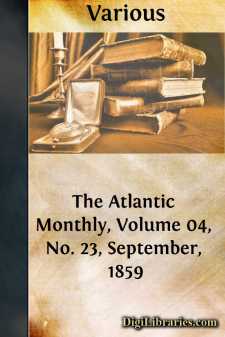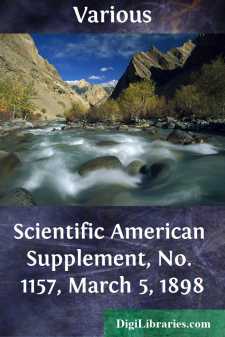Categories
- Antiques & Collectibles 13
- Architecture 36
- Art 48
- Bibles 22
- Biography & Autobiography 813
- Body, Mind & Spirit 142
- Business & Economics 28
- Children's Books 15
- Children's Fiction 12
- Computers 4
- Cooking 94
- Crafts & Hobbies 4
- Drama 346
- Education 46
- Family & Relationships 57
- Fiction 11828
- Games 19
- Gardening 17
- Health & Fitness 34
- History 1377
- House & Home 1
- Humor 147
- Juvenile Fiction 1873
- Juvenile Nonfiction 202
- Language Arts & Disciplines 88
- Law 16
- Literary Collections 686
- Literary Criticism 179
- Mathematics 13
- Medical 41
- Music 40
- Nature 179
- Non-Classifiable 1768
- Performing Arts 7
- Periodicals 1453
- Philosophy 64
- Photography 2
- Poetry 896
- Political Science 203
- Psychology 42
- Reference 154
- Religion 513
- Science 126
- Self-Help 84
- Social Science 81
- Sports & Recreation 34
- Study Aids 3
- Technology & Engineering 59
- Transportation 23
- Travel 463
- True Crime 29
The Atlantic Monthly, Volume 04, No. 23, September, 1859
by: Various
Categories:
Description:
Excerpt
The Life and Works of Ary Scheffer.
No painter of this age has made so deep an impression on the popular mind of America as Ary Scheffer. Few, if any other contemporary artists are domesticated at our firesides, and known and loved in our remotest villages and towns. Only a small number, indeed, of his original works have been exhibited here,—yet engravings from them are not only familiar to every person of acknowledged taste and culture, but are dear to the hearts of many who scarcely know the artist's name. Young maidens delight in their tender pathos, and the suffering heart is consoled and elevated by their pure and lofty religious aspiration. An effect so great must have an adequate and peculiar cause; and we shall not have far to seek for it, but shall find it in the aim and character of the artist. Scheffer has two prominent qualities, by which he has won his place in the popular estimation. The first is his sentiment. His works are full of simple, tender pathos. His pictures always tell their story, first to the eye, next to the heart and soul of the beholder. His admirable knowledge of composition is always subordinate to expression. His meaning is not merely historical or poetical, but is true to life and every-day experience. "Mignon regrettant sa Patrie" is felt and appreciated by those who have never sung,
"Kennst du das Land wo die Citronen blühen,"—
and "Faust" and "Margaret" tell their story to all who have felt life's struggles and temptations, whether they have read them in Goethe's version or not. Added to this power of pathos and sentiment is the deep religious feeling which pervades every work of his pencil, whatever be its outward form. His religion is of no dogma or sect, but the inflowing of a life which makes all things holy and full of infinite meaning. Whether he paint the legends of the Catholic Church, as in "St. Augustine" and "St. Monica," or illustrate the life-poem of the Protestant Goethe, or tell a simple story of childhood, the same feelings are kindled, in our heart's faith in God, love to man, the sure hope of immortality. It is this genuine and earnest religion of humanity which has made his works familiar to every lover of Art and sentiment, and given us a feeling of personal love and reverence for the made artist.
It is now nearly a year since his labors on earth terminated, and yet no adequate account of his life and labors has appeared. It is very difficult to satisfy the craving desire to know more of the personal life and character of him who has been a household friend so long. Yet it is rather the privilege of succeeding generations, than of contemporaries, to draw aside the veil from the sanctuary, and to behold the works of a man in his greatest art,—the art of life. But the cold waters of the Atlantic, like the river of Death, make the person of a European artist sacred to us; and it is hard for us to realize that those whom we have surrounded with a halo of classic reverence were partakers of the daily jar and turmoil of our busy age,—that the good physician who tended our sick children so faithfully had lived in familiar intercourse with Goethe, and might have listened to the first performance of those symphonies of Beethoven which seem to us as eternal as the mountains....












